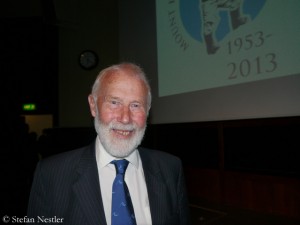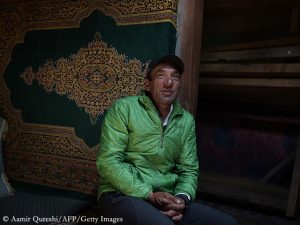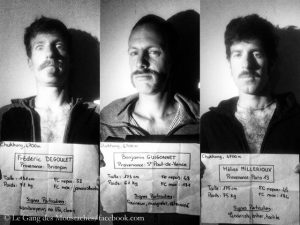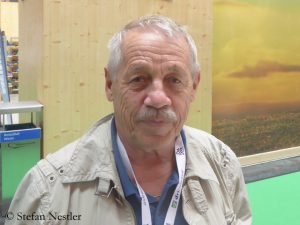Bonington: The pioneers have gone elsewhere
When Everest was climbed first in 1953 Chris Bonington was a young English mountaineer of 17 years. Later he did historic climbs like the first ascents of Annapurna II in 1960, of the Central Pillar of Freney on the south side of Mont Blanc in 1961 and of the 7285-meter-high Ogre in the Karakoram together with Doug Scott in 1977 (the second ascent followed only in 2001). But Bonington also proved to be a great expedition leader. In 1970 he led the successful expedition to the South Face of Annapurna, in 1975 the expedition to Mount Everest, during which Doug Scott and Dougal Haston climbed the Southwest Face first. Bonington himself reached the summit of Everest in 1985 as a member of a Norwegian expedition. He was knighted by the Queen in 1996 for his services to the sport. I met the 78-year-old climber last week at the diamond jubilee celebration of the first ascent of Mount Everest in the Royal Geographical Society in London and asked him – of course – about his thoughts on Everest.
Sir Chris Bonington, 60 years after the first ascent of Mount Everest, how do you feel about these pioneers?
I’m a great believer in the heritage of our sport, looking back, enjoying and learning from what our predecessors have done. In a way that first ascent of the highest point on earth is one of the very, very great occasions. I think it’s story. How they succeeded and worked together, it was a superb team effort. It’s something very special.
Hillary was a New Zealander, Tenzing Norgay a Sherpa living in India, but I think it was a great push for British mountaineering because it was a British expedition which was first successful on Everest.
British and New Zealand, because George Lowe and Ed Hillary were two important parts of it. It was a Commonwealth expedition. But the key thing was that the individuals who came together were undoubtedly melted as a team by John Hunt who was a supreme leader. I think he provided a blue print of how to go about planning, organizing and leading an expedition. It was the achievement of all which of course Ed Hillary and Sherpa Tenzing Norgay kind of completed.
Has it been an initial point for your generation to do something more difficult?
That’s a natural progression going from the base what has been done in the past to take one step further into the future. And therefore naturally the next generation is trying to take it on other levels. When for instance we climbed the Southwest Face of Everest, that was the next thing to do. Reinhold Messner’s solo ascent of Everest from the north was an extraordinary step. There have been a whole series of developments on Everest and within the mountain as a whole.
But it seems to me that after this era there was a step back when commercial mountaineering took over.
No, it’s not a step back, it’s just natural evolution. You can see exactly the same thing happening in the Alps where mountains like the Matterhorn or Mont Blanc are guided. Hundreds of people go up every single day guided by professional mountain guides. It was almost an inevitable thing that was going to happen in the Himalayas and it has done. And it’s enabled hundreds of people to reach the top of Everest. It’s not a give-away, it’s still a tough game for those individuals, 2000 people at basecamp, 200 people going up the Lhotse face, 100 people going to the summit in a day aligned on a fix rope put up by the Sherpas. That’s something that happens. But what the elite of climbers are doing – and they do extraordinary things – is climbing Alpine style in very small parties, four maximum, usually two, very often solo. That is climbing adventure at its upmost. There are still thousands of unclimbed ridges and faces in the Himalayas on the peaks around 8000 metres. Everest, if you like, is no longer a place for the pioneers. The pioneers have gone elsewhere.
Sir Chris Bonington about commercial climbing on Everest
This spring brought a Sherpa attack against the European top climbers Simone Moro and Ueli Steck in Everest high camp. What do think about it?
I think that was very unfortunate. I’ve got a great respect and liking for Ueli, I know him and Jon Griffith, the English climber (who was also involved in the brawl). They were doing a kind of acclimatization climb up the Lhotse face to the South Col, maybe dumping a bit of stuff there as well in preparation for what they were planning to do, which was actually to do an amazing ascent. They were trying to keep out of the way of the Sherpas. In no way they did interfere with them. I think there has been a lot of tension and resentment by the Sherpas perhaps feeling that they had not been paid enough. Lots of things that have nothing to do with what these three climbers were doing. But there was a configuration and the Sherpas attacked them. I think that was unforgivable, it was appaling and very unfortunate. But what it highlighted was that the whole system on Everest needs to have a serious look. What is needed is that the commercial expedition leaders, the government, the Sherpa community, all the various people involved on Everest, need to get together and have a serious talk about how can we improve the situation. There is something that needs to be done by consultation, talk and discussion.
Sir Chris Bonington about the brawl on Everest
Would you say it’s a conflict that has emerged long ago and has now broken out?
I think it has been simmering for quite some time. It’s the same with everything. When there are too many people, when there are two bigger crowds, when that kind of pressure is involved, when money is involved as well, that’s why things start going wrong.








